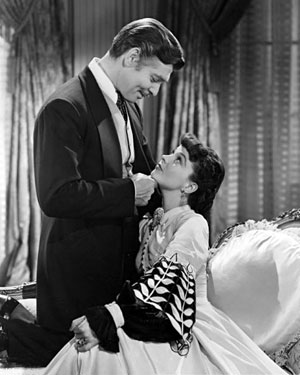Film: Jessica Kellgren-Hayes
gone with the wind
Gone with the Wind, Margaret Mitchell’s Pulitzer Prize-winning novel, is one of the bestselling books of all time, with at least 28 million copies having been published in nearly every language. The story’s immortality was secured by David O. Selznick’s 1939 film adaptation, a winner of eleven Academy Awards.
It is an epic, almost operatic saga set throughout the civil war. Kittenish Southern belle Scarlett O’Hara, a girl so pampered that even to put her face in the sun is considered too tiring, is in love with the self-consciously chivalrous Ashley Wilkes. She near destroys the lives of those around her for his love, when really she is more in love with the idea of being in love with him. And even that is with the ideal version of him.

In steps handsome rogue Rhett Butler, a man who sees through Scarlett’s airs and pretences, as he hides none of his own ‘uncouth’ humanity. Theirs is a relationship borne of hate but really rooted in love. No matter how much they argue and throw things, they will never be able to escape from being each other’s perfect match.
MGM took a risk in casting Vivien Leigh as Scarlett; this was one of the most talked about and coveted roles in Hollywood to date and they chose an English nobody with the wrong colour eyes (handily changed in post-production). The risk paid off as the tepid tale of thwarted love amid the ashes of the old South leaps from the page to become one of the greatest love stories of all time. Clark Gable unforgettably incarnates Rhett, but this film would be nothing without Scarlett. Leigh’s lively brilliance makes Scarlett believable.
It isn’t perfect: it’s disturbingly lenient to the Confederacy and does a sterling line in “happy slaves”. Gone with the Wind was released into cinemas when there were still people living who had memories of plantations and the American slave trade. Yet, grotesquely, the black characters are shown as being clearly better off under slavery and the war does nothing to help them. Let’s also not forget the film’s insistence that a gentleman may feel free to assert his conjugal rights.
However, whether you are watching on a cinema screen, television screen or indeed, your laptop, the huge exteriors and skylines ablaze have a dreamlike, expressionist quality that radiates. Gone With The Wind was one of the first films to be made in splendid, expensive Technicolor. Not only is the film fabulous for its modern heroine and refusal to give a neat conclusion, it also doesn’t shy away from amassing as many clichés as it possibly can. After all, you’ll like at least one of them, right?
For more classical reviews subscribe to my YouTube channel, youtube.com/user/MissJessicaKH, and watch PostFeature every Wednesday night at 6.30 for more on the latest cinema releases.




















